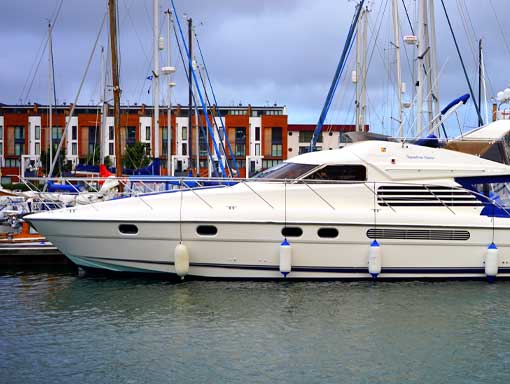Bottom painting is one of the several ongoing expenses you will need to plan for when you purchase a boat. You don’t have to do it every single year, but unless you keep your boat in pristine, freshwater, you will still need to do it. That brings about the question, how much does it cost to antifoul a boat? On average, you’d be looking at around £30 per foot. If you have a 25-foot boat, you’d be looking at around £500. The price can of course, vary quite a lot and there are numerous variables that can influence the cost as well. Take a look below to learn more about the prices of antifouling.
Average Cost of Traditional Antifouling for Boat Owners
The average price of traditional antifouling can range from £300 for a 20ft boat, to over £800 for a 50ft boat. Normally, when you invest in a traditional antifouling service, you’ll be paying for the cost of the paint, the labour and any consumables. You will also be paying for the insurance, disposable charges and environmental impact as well. The cost to paint the bottom of your boat will vary depending on the service yard that you go to as well, as the cost can quickly add up. Some providers choose to give you a price per foot for the job, other service providers choose to give you an estimate based on your entire boat in general. The specific paint options you choose will also impact the price, as paint quality varies and so does the cost. A 4.5 litre tin of paint can start from £30, but it can stretch up to £150. Most service yards will estimate how much painting needs to be done, but the final bill could be much more, or much less than you anticipated. The service yard should be able to advise you on what paint you need as well, but again, it helps to do your own research if possible.
What Adds to the Price of the Antifouling Service?
Prices for antifouling can vary. A longer boat doesn’t have a simple linear correlation between the length and the amount of paint you need. If you have a Catalina Capri 22, this may need less than 5 litres of paint for the job. If you look at a boat that is over 50-foot, then this may take 45 litres of paint for a good application by an experienced service provider. In other words, you have a boat that is double the length, but ten times the price. This all comes down to displacement. Boats that have more displacement will require more labour and it will also require more materials to paint, meaning that the job will cost more. Different service providers will also have different prices, depending on their level of experience. If you want to get a good idea of the rate you are going to pay, make sure that you do your research beforehand. Some companies will charge a higher rate, but as mentioned, they may have more experience or access to better technology.
The Additional Cost of Prep Work and Materials
Ideally, your bottom will only require a light clean and sand before the new paint is applied. This is a good amount of labour, but the conditions are never usually ideal. If you have paint that is flaking, then this will require additional preparation before painting can be done. Bottoms with growth will require even more time, materials and effort to prepare. The yard will usually pressure wash the bottom when it is hauled, but more effort may be required on top of this to remove build-up. If you maintain your boat, you can reduce the cost of this significantly.
How Does Ultrasonic Tech for Antifouling Work?
Ultrasonic antifouling uses digital transducer technology. This works by emitting ultrasonic waves, which create a pattern of both positive and negative pressure. Bubbles are then created as the result of this pressure, which implode. It’s this imposing that helps to clean the hull, below the waterline. The reason why ultrasonic fouling is so popular is because it destroys algae, which is of course, the base component of the underwater ecosystem. This helps to stop further growth, giving you more time between getting your maintenance done.
Ultrasonic antifouling has been around for over 30 years, but it’s only been used in the marine industry in the last decade. This method was primarily used for cleaning dental or medical equipment, with the process sometimes being used for jewellery as well. Environmental issues have also arisen as the result of traditional antifouling methods, paving the way for ultrasonic antifouling as a preferred solution for yards and service providers.
Is Ultrasonic Antifouling Cheaper than Traditional Antifouling?
When you invest in ultrasonic antifouling, you will soon find that you can take advantage of a huge range of savings. The cost of an ultrasonic antifouling kit stands at around £1250, with a solar-powered kit being around £350 on top. Even though the initial outlay is more expensive when compared to traditional antifouling, the cost-savings make it a much more affordable solution overall. Having a fully clean full will reduce your fuel bills by up to 30% because fouling on your hull will lead to more resistance, so you’ll burn far more fuel for every knot. Ultrasonic antifouling is preventative as well, not to mention that it is harmless to marine animals and humans.
Of course, ultrasonic antifouling allows for reduced maintenance as well. The need to lift out and scrub the hull is dramatically reduced, and as mentioned above, this will save you a huge amount of money in terms of labour and material cost. It will also get the job done better as well. It’s safe to say that ultrasonic antifouling is the future, and that it’s more than possible for you to save money by simply investing in the better and more efficient method of cleaning your boat. It doesn’t even matter how big your boat is either, because ultrasonic antifouling is more than suited to every size of yacht, regardless of how big or small it may be.
A Far Better Solution
It’s safe to say that ultrasonic antifouling is a far better solution when compared to traditional antifouling. It’s easier, less time consuming and most of all, it doesn’t harm the environment. The overall cost savings are not to be overlooked either, meaning that you can save in the long run by paying cheaper prices. If you are still unconvinced, check out our blog, does ultrasonic antifouling work?
If you want to find out more about ultrasonic antifouling or if you want to find out more about our prices in general, then you can contact us today. When you do get in touch with us, you can count on us to help you with just about anything you need, and we can also advise you on the antifoul products that we have available as well.



